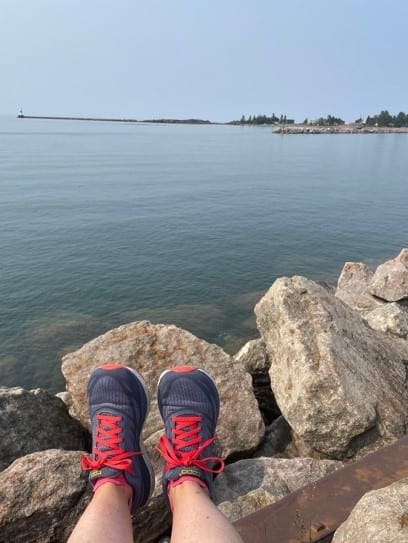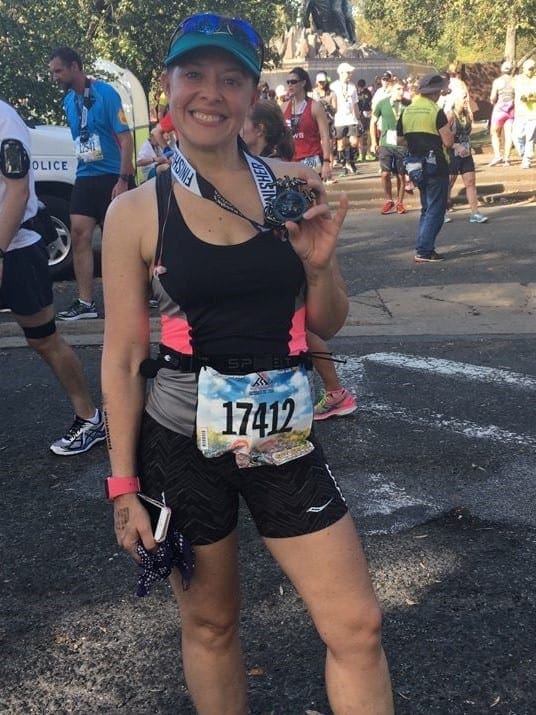I’ve been a runner for half of my 50-year life. I’ve had a coach for one-eighth of my life, which has given me my fastest mile, 5k, and half-marathon. To be clear: I haven’t had a private coach, but I’ve followed a variety of Train Like a Mother programs, which are designed by expert coaches and, during the training process, offer direct access to said expert coaches. So I’ve been coached in a team setting.
While I love the structure and specifics of the coach’s workouts and advice during the program, I’ve kind of embraced a typical teenager’s attitude: I’m told what the best thing to do is, and yet I do something different anyway. Teenagers are driven by the lack of a fully functional frontal lobe, and I’m driven by the self-knowledge I’ve gained through miles and miles. I know myself best.
Do you know what I don’t know best? Running.
Know what the Train Like a Mother coaches know best? That’s right… running.
I’m training for my sixth marathon—the Air Force Marathon, using the Heart + Sole marathon Level 2 program.. I decided it’s time to give up the 16-year-old’s attitude and surrender to the program: do all I can do to follow it as best I can.
To get a coach’s perspective on this typical dilemma, I talked to Jennifer Harrison, who coaches the Heart + Sole, triathlon, and Become a Cyclist programs with her co-coach, Elizabeth Waterstraat.
From the outside, Coach Jen explained that the biggest benefit of coaching—or being a structured, detailed program—is that it takes the thinking away from you. They pour their energy and effort into creating workouts built for your goal and athletic experience, so you don’t need to sweat the details. (But you do, however, need to sweat. Quite a bit.) I don’t know about the rest of you, but if someone wants to do the thinking for me in a part of my life, I’m all in.
Coach and I talked about three facets of being coached and how to best take advantage of being trained.

Relaxing by Lake Superior after a vacation run.
Follow the Plan (Or Don’t Wait for Motivation)
Seems simple enough, but how many times have you thought that this would be ok? I know I’m supposed to do an easy run today, but my friends are all faster than I am, so I’ll just go faster. It will be fine.
Or how about this chart-topping hit? I can’t motivate to do my run today. I’ll do it tomorrow.
Or maybe you’re familiar with this little situation? I’ve got hard intervals on my schedule today, but I’m just not feeling it. I’ll turn it to an easy run (again).
Here is what your coach wants you to know: you need to be consistent and follow your program if you want to set yourself up for your best results on race day.
Can you be flexible? Of course. You can move workouts around to fit with your life. I’m writing this on a rooftop in northern Minnesota on the shores of Lake Superior. I had no desire to run for 2.5 hours while on vacation, so I fit my long run in Thursday night at home. Then I did the planned 45-minute run this morning up the Gunflint Trail. I’m still consistent and have kept to the plan.
Coach Jen says of course you will have days that you just can’t do the workout. We all do. Don’t worry about those as long as they are genuinely few and far between. The key is keeping your running wits about you: don’t overrun the easy runs, don’t under-run the hard runs, and, perhaps most importantly, don’t wait for motivation.
Even the winners who get sprinkles and podiums don’t think, “I’m so excited to run for three hours today.” But they do it because three hours is on the program.
Do the Extras that Aren’t Really Extras
I’m talking about strength circuits, foam rolling, and cross-training here. Yes, running the miles is important, and these parts of your plan must be prioritized. Especially for those of us who are mid-century. “People need to stop skipping the extras,” she says. (You can roll your eyes at all day long if it makes you feel superior—just ask your teen how powerful an eye roll can be—but you must hit the weights, the foam roller, the bicycle.)
While Coach Jen, who likes to marinate in chlorine as often as possible, says the best cross-training for your time is swimming, there are many options available to you. Make it fun: consider cross-training your athlete social hour and ask those speedy friends to go biking. Or do some #motherrunner multitasking by doing Pilates or yoga: strength, flexibility, and cross-training all wrapped up in one package.
If you find yourself with an injury or you have a big goal, you’re going to need to increase the effort—and likely the expense. “Hire the best. Maybe that’s a physical therapist or a strength coach or a massage therapist, or some combination of the three.” Coach Jen practices what she preaches: she drives an hour each way to meet with her strength coach. There is power in having a team of people to help you meet your goals and take care of your body. Skip these extras and you risk injury. Prioritize them and you get so much closer to meeting your goal.
Nutrition: Don’t Miss the Opportunity
For years I struggled with my running nutrition. I’ve tried Gu gels, Cliff chews, raisins, date bites, and the classic PB + J. Nothing seemed to work like I need it to. I’ve been left feeling hungry, heart burned. and, most of the time, not fueled at all. Once, I quite literally considered asking a stranger for money to buy a hot dog at mile 15 of the Marine Corps Marathon.

Alana still thinking about that hot dog
During my most recent half-marathon training, AMR and Coach Jen hosted a webinar and explained how much one should consume on an endurance run (per hour: 200-250 calories, which should include 30-60 g of carbs, as well as 20-24 ounces of hydration).
Surely not me, I thought. I must have to adjust for size and speed. (I’m what one might call small and slow). What do these coaches know?
And then I reminded myself that I am not a running expert, and I am committed to listening to my coaches. I explained my finicky, unsatisfied belly, and Coach Jen suggested trying liquid calories instead of calories from gels/chomps/solids. I did some solid teenage grumbling under my breath while I researched and bought Tailwind and Skratch. The next weekend, I did a 2-hour run in Minnesota mid-summer humidity, and my body was humming (a good thing). I felt strong and capable. Not hungry the entire time.
Hmmm, look at that. Amazing what happens when you actually follow helpful, accessible advice.
When I asked Coach Jen what she wishes runners would do differently as it pertains to nutrition, her answer was simple: “Just eat.” Everyone thinks they are the exception to the rule. You’re not. (That does not mean you’re not special; your body just needs calories when you’re running long and racing.)
How you take in your calories is more individual; you have to experiment with what works for you. You will probably need to test a few different products before you find out what is best for you. Start at your local running shop, ask for some suggestions, grab a few, and see what works. If you really can’t find a solution, hire a registered dietician and have them help you trouble-shoot. (Here is that advice again: if you’re looking for your best results, hire it out.)
[Want more specifics on nutrition? Check out Nutrition for Running: Half Marathon and Marathon]
How many times have we uttered the phrase, I just wish my kids would listen to me?
Guess what? Your coach is wishing for the exact same thing.






This was so well written – and so bang on!! Thanks for giving my inner teenager a talking to 😉
Alana, did you come up with all those excuses from reading my mind?!?! The trouble with having done these programs for so many years is I think I know it all. I don’t. Still learning after 10 years of running half marathons. So glad to have coaches do the thinking for me and fellow runners like you preaching the truth of the matter and out there inspiring and motivating me to do what works! Thx !